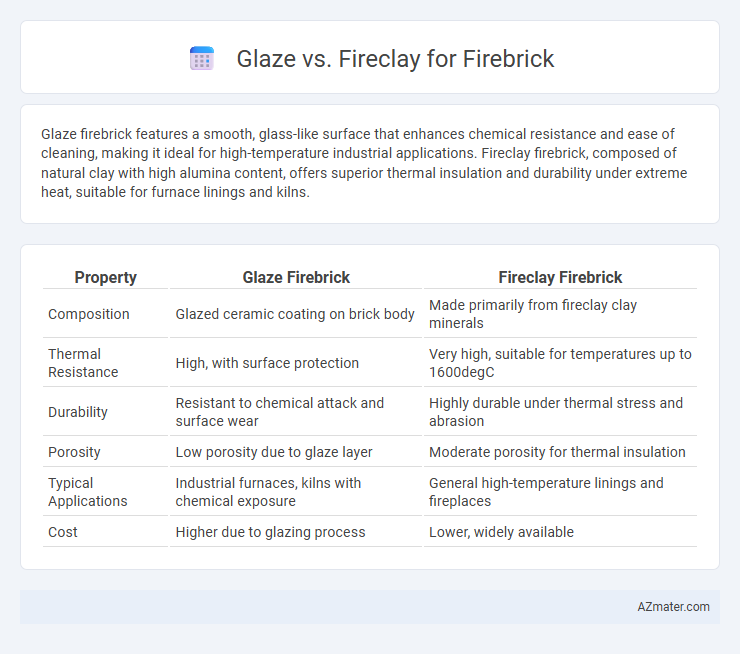Glaze firebrick features a smooth, glass-like surface that enhances chemical resistance and ease of cleaning, making it ideal for high-temperature industrial applications. Fireclay firebrick, composed of natural clay with high alumina content, offers superior thermal insulation and durability under extreme heat, suitable for furnace linings and kilns.
Table of Comparison
| Property | Glaze Firebrick | Fireclay Firebrick |
|---|---|---|
| Composition | Glazed ceramic coating on brick body | Made primarily from fireclay clay minerals |
| Thermal Resistance | High, with surface protection | Very high, suitable for temperatures up to 1600degC |
| Durability | Resistant to chemical attack and surface wear | Highly durable under thermal stress and abrasion |
| Porosity | Low porosity due to glaze layer | Moderate porosity for thermal insulation |
| Typical Applications | Industrial furnaces, kilns with chemical exposure | General high-temperature linings and fireplaces |
| Cost | Higher due to glazing process | Lower, widely available |
Introduction to Firebrick Materials
Firebrick materials primarily consist of either glazed or fireclay compositions, each offering distinct thermal and durability properties. Glazed firebricks feature a smooth, glass-like coating that enhances resistance to chemical erosion and facilitates easier cleaning, making them suitable for decorative or light-duty applications. Fireclay firebricks, composed of alumina and silica-rich clay, provide superior refractory strength and thermal shock resistance, ideal for high-temperature industrial furnaces and kilns.
What is Fireclay?
Fireclay is a type of refractory clay known for its high alumina and silica content, which provides excellent heat resistance and durability in firebrick applications. It is commonly used to manufacture firebricks because it can withstand extreme temperatures without cracking or degrading. Compared to glaze, fireclay firebricks offer superior thermal stability and are preferred for lining kilns, furnaces, and fireplaces.
Understanding Glaze in Firebricks
Glaze in firebricks enhances durability by forming a smooth, glass-like coating that resists moisture, chemical exposure, and thermal shock. Fireclay firebricks, inherently rich in alumina and silica, provide a strong, heat-resistant base that complements the protective glaze layer. Understanding glaze involves recognizing its role in preventing surface erosion and improving the brick's lifespan in high-temperature environments such as kilns and furnaces.
Fire Resistance: Glaze vs Fireclay
Fireclay firebrick offers superior fire resistance due to its dense composition and ability to withstand extreme temperatures up to 1600degC, making it ideal for high-heat applications like kilns and furnaces. Glazed firebrick has a ceramic coating that can reduce its overall thermal resistance and may crack or degrade under rapid temperature fluctuations. Choosing fireclay firebrick ensures enhanced durability and sustained performance in environments demanding prolonged exposure to intense heat.
Durability Comparison
Firebrick with a fireclay composition offers superior durability compared to glazed firebrick due to its high resistance to thermal shock, mechanical wear, and chemical corrosion. The natural refractory properties of fireclay ensure prolonged lifespan in high-temperature environments, whereas glazed firebrick may experience surface degradation and cracking under intense heat cycles. Fireclay firebrick maintains structural integrity and thermal efficiency under extreme industrial conditions, making it the preferred choice for heavy-duty applications.
Heat Retention Capabilities
Firebrick with a fireclay base offers superior heat retention capabilities compared to traditional glazed firebricks due to its dense and refractory composition. Fireclay bricks can withstand higher temperatures and maintain heat longer, making them ideal for applications involving prolonged exposure to intense heat. Glazed firebricks, while easier to clean, tend to have lower heat retention and are better suited for decorative or lower-temperature uses.
Maintenance and Cleaning
Glaze firebricks offer a smooth, non-porous surface that resists staining and simplifies cleaning, making maintenance easier by preventing soot and residue buildup. Fireclay firebricks have a more porous texture that can absorb soot and require more frequent scrubbing and specialized cleaners to maintain their appearance. Choosing glazed firebricks reduces the time and effort needed for upkeep, especially in high-use fireplaces or kilns.
Cost Differences
Glaze firebrick typically costs more than fireclay firebrick due to the specialized coating process that enhances durability and resistance to chemical attacks. Fireclay firebrick, made from natural clay materials, offers a more budget-friendly option while still providing good thermal insulation and resistance to high temperatures. Choosing between glazed and fireclay firebrick depends largely on the specific application's performance requirements and budget constraints.
Best Applications for Each Material
Glaze firebrick is ideal for environments requiring enhanced chemical resistance and smooth surfaces, such as in glass furnaces and decorative kilns. Fireclay firebrick excels in high-temperature structural applications like furnace linings and industrial boilers due to its superior thermal shock resistance and durability. Selecting the appropriate material depends on whether surface finish or mechanical strength is prioritized in the specific high-heat application.
Choosing the Right Firebrick for Your Needs
When choosing between glaze and fireclay firebrick, consider the intended application and exposure to heat. Glaze firebricks offer a smooth, glass-like surface that resists chemical corrosion and is ideal for decorative or moderate heat environments, while fireclay firebricks provide superior thermal resistance and durability, making them suitable for high-temperature industrial furnaces and kilns. Evaluating factors such as maximum operating temperature, thermal shock resistance, and chemical exposure will help ensure the right firebrick matches your specific thermal and structural requirements.

Infographic: Glaze vs Fireclay for Firebrick
 azmater.com
azmater.com